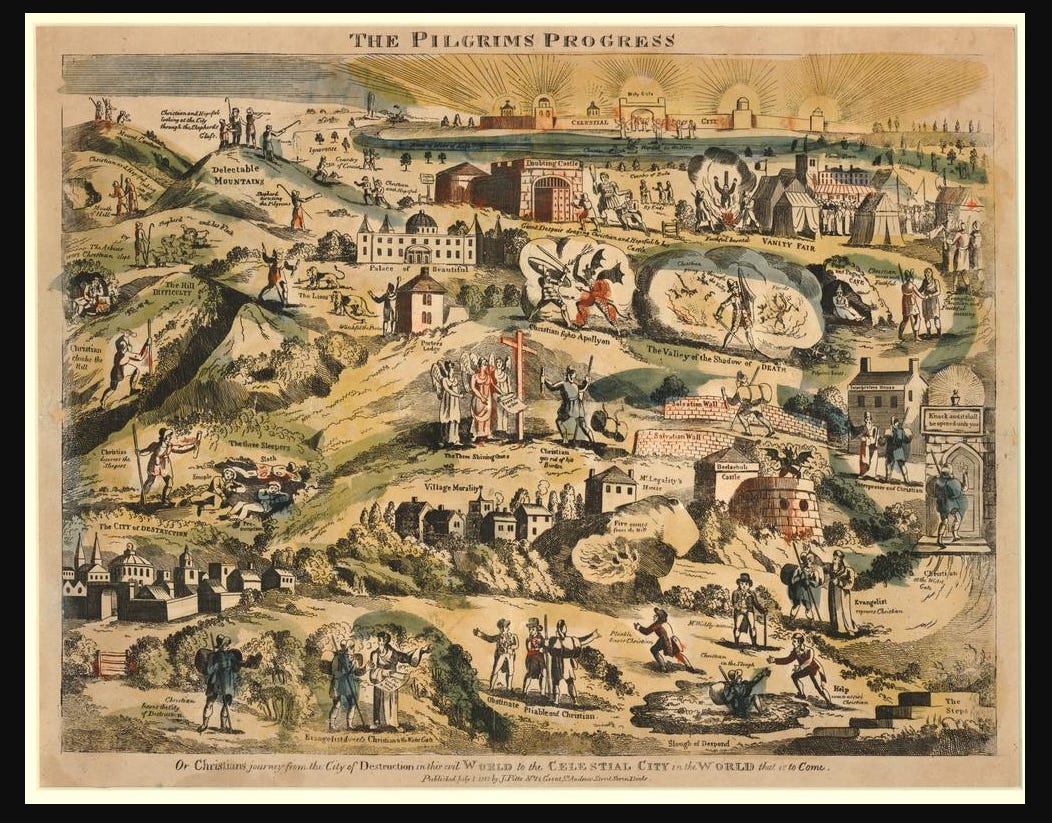When John Bunyan published The Pilgrim’s Progress from This World to That Which is to Come (1678) he had years of (illegal) ministry, imprisonment, hard work to support his family, and conscripted military service during the English Civil War. His lived experience and revelations about his desires to live a meaningful life became the most beloved Christian allegory.
Of course with my obsession for how pilgrimages are mapped, whether as narrative or imagery, I focus in on the pivotal moment when Pilgrim, whose name then becomes the unburdened Christian, is illustrated.
Studying the Pitts 1813 map (online archive British Museum) I see that Pilrgim’s heavy burden goes bouncing downhill towards the bottom of the Salvation Wall, where legend has it in the village of Stevington, England, it landed in a deep holy well and disappeared beneath the surface forever.
Dreamy…
How I wish our current political, religious, and ethical burdens would do the same - just drop away and drown - especially for all of us struggling to make sense of what has happened in our own landscape across the Pond from Bedford. This would be an interesting period in the religious and political life (or death?) of our country’s journey through its decades long upheaval and current chaos swirling around the characters of Grift, Greed, Hypocrisy, Vanity, and Giant Despair.
Sounds like a project I’d be willing to try but I’ll need an entire wall on which to hang a big piece of paper. It wouldn’t just be the journey of one man but of a whole democratic society. And where will I find a big enough piece of paper to do that? And will it cost more to buy because large art papers like that are all made in Canada or Mexico. What would be the well on my map where burdens go to drown be named? How About the “Gulf of ___(insert make-believe name)___” ?
Dreamy indeed.
Allegorical writing and mapmaking bases a lot of its creative inspiration upon actual landscapes and this was certainly the case for John Bunyan whose narrative includes thinly veiled place names and descriptions found in and around Bedford, his hometown, to include Stevington, about five miles northwest.
In Mayhew-Smith and Hayward’s excellent 2020 guide book Britain’s Pilgrim Places the authors describe St Mary the Virgin Church and the holy well linked to Bunyan’s preaching circuit. The village cross served as his podium to preach against hypocrisy and all other sins of the human condition. “The village cross is thought to be the place where the book’s hero, Christian, loses the burden from his back.” (114)
The holy well still flows today as a spring seepage that runs through an arched opening in the stone wall just below the church. Though much of it is now filled in with sediment its waters run across alluvial low ground to the River Ouse nearby. At the time of Bunyan’s preaching and imprisonment in the Bedford Gaol, the wetland area we see today was maintained to some considerable depth to allow full immersion baptism, more akin to a pond or water tank. So, that big load of burden could well have sunk clean out of sight.

Between the end of the 17th century and the modern era this holy well fell into disrepair and suffered from neglect. But, as pilgrimage began to re-emerge in England as a healthy and spiritual pastime released from its monarchial ordered banishment by the Church of England, the importance of this and other holy wells as destinations to those seeking out the Old Ways became clear.
The village of Stevington rallied around its little spring and did the hard work of rescuing it from overgrowth and its near disappearance, a fate many hundreds of holy wells across Britain have suffered. It has not, however, been excavated to restore it to its original late medieval period depth due to environmental concerns, which is fair and needed.
Check out Where’s Kathyrn’s blog post on hiking the John Bunyan Trail which itself has transformed from a recreational walking loop (created and maintained by the local rambling club) into a legit pilgrimage path with the support of cultural and church organizations.




